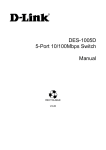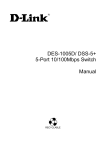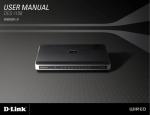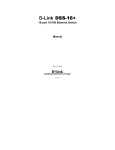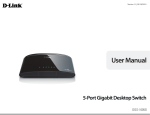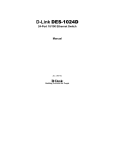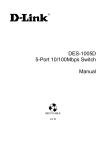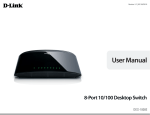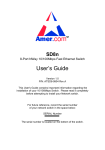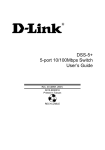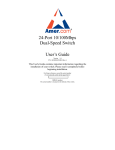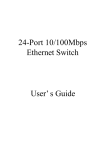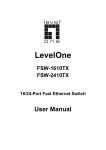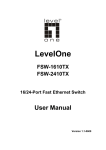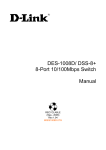Download D-Link DES-108 Specifications
Transcript
DES-105/108 5/8-Port 10/100Mbps Unmanaged Switch Manual RECYCLABLE V2.00 TABLE OF C ONTENTS ABOUT THIS GUIDE .......................................................................1 PURPOSE.............................................................................................1 INTRODUCTION ..............................................................................2 FAST ETHERNET TECHNOLOGY .........................................................2 SWITCHING TECHNOLOGY .................................................................2 802.1P AND QOS ................................................................................3 FEATURES ..........................................................................................4 UNPACKING AND SETUP ..............................................................6 UNPACKING........................................................................................6 SETUP .................................................................................................6 IDENTIFYING EXTERNAL COMPONENTS ..............................7 FRONT PANEL ....................................................................................7 REAR PANEL ......................................................................................8 CONNECTING THE SWITCH ......................................................10 CONNECTING THE SWITCH ......................................................10 PC TO DES-105/108.........................................................................10 HUB TO DES-105/108 ......................................................................10 DES-105/108 TO OTHER DEVICES ....................................................10 PORT SPEED & DUPLEX MODE ........................................................11 MOUNTING THE SWITCH ON A WALL...................................12 TECHNICAL SPECIFICATIONS .................................................13 RJ-45 PIN SPECIFICATION .........................................................15 ii A BOUT T HIS G UIDE Congratulations on your purchase of the D-Link DES-105/108. This device integrates 100Mbps Fast Ethernet and 10Mbps Ethernet network capabilities in one high-performance, easy-to-use solution. Purpose This manual will familiarize you with the DES-105/108 and guide you through the installation process. 1 I NTRODUCTION Fast Ethernet Technology The growing importance of LANs and the increasing complexity of desktop computing applications are fueling the need for high performance networks. 100BASE-T (Fast Ethernet) provides a cost-effective and highperformance solution for small workgroups, SMBs (Small to Medium Businesses), and any network supporting bandwidth-intensive applications. Fast Ethernet technology operates at 10 times the speed of traditional Ethernet, offering maximum performance and enhanced capability for existing Ethernet-based networks. 100Mbps Fast Ethernet is a standard specified by the IEEE 802.3 LAN committee. It is an extension of the 10Mbps Ethernet standard with the ability to transmit and receive data at 100Mbps, while maintaining the CSMA/CD Ethernet protocol. Since the 100Mbps Fast Ethernet is compatible with all other 10Mbps Ethernet environments, it provides a straightforward upgrade and takes advantage of the existing investment in hardware, software, and personnel training. Switching Technology Switching is a cost-effective way of increasing the total network capacity available to users on a LAN. If an Ethernet network begins to display symptoms of congestion, low throughput, slow response times, and high rates of collision, installing a switch to a network can preserve much or all of the existing network's cabling and workstation interface card infrastructure, while still greatly enhancing the throughput for users. A switch is a viable solution even if demanding applications, such as multimedia production and video conferencing, are on the horizon. The most promising techniques, as well as the best return on investment, could well consist of installing the right mixture of Ethernet switches. A switch increases capacity and decreases network loading by dividing a local area network into different LAN segments. Dividing a LAN into 2 multiple segments is one of the most common ways of increasing available bandwidth. If segmented correctly, most network traffic will remain within a single segment, enjoying the full-line speed bandwidth of that segment. Switches provide full-line speed and dedicated bandwidth for all connections. This is in contrast to hubs, which use the traditional shared networking topology, where the connected nodes contend for the same network bandwidth. When two switching nodes are communicating, they are connected with a dedicated channel between them, so there is no contention for network bandwidth with other nodes. For Ethernet networks, a switch is an effective way of eliminating the problem of chaining hubs beyond the “two-repeater limit.” A switch can be used to split parts of the network into different collision domains, making it possible to expand your Ethernet network beyond the 205-meter network diameter limit for 100BASE-TX networks. Switches supporting both 10Mbps Ethernet and 100Mbps Fast Ethernet are also ideal for bridging between existing 10Mbps networks and newer 100Mbps networks. Switching LAN technology is a marked improvement over the previous generation of network hubs and bridges, which were characterized by higher latencies. Routers have also been used to segment local area networks, but the cost of a router, the setup and maintenance required, make routers relatively impractical. Today switches are an ideal solution to most kinds of local area network congestion problems. 802.1p and QoS The DES-105/108 Switch supports 802.1p priority queuing Quality of Service. The implementation of QoS (Quality of Service) and benefits of using 802.1p priority queuing are described here. 3 Features The DES-105/108 is a high performance switch designed specifically for environments where traffic on the network and the number of users increase continuously. DES-105/108 implements D-Link’s Green Technology special powersaving features under speed at 100Mbps that link status and adjust power usage accordingly. Further, D-Link Green implements the newly ratified IEEE 802.3az Energy Efficient Ethernet standard for reducing energy consumption of network links during periods of low utilization by transitioning interfaces into low-power state without interrupting the network connection. DES-105/108 has special front access design for Ethernet ports/LEDs to help user easier to understand and control network status. Metal case design is useful for strengthening cooling and suitable for departmental environment, providing users the best performance. DES-105/108 was specially designed for small to mid-size workgroups and can be installed where space is limited. The DES-105/108 is ideal for deployment with multiple high-speed servers for 10Mbps or 100Mbps shared-bandwidth workgroups. With the highest bandwidth at 200Mbps (100Mbps full-duplex mode), any port can provide workstations with a congestion-free data pipe for simultaneous access to the server. The DES-105/108 is scalable, allowing two or more DES-105/108 to be cascaded together. Since all ports support 200Mbps, any one of its five ports may be used to cascade to an additional switch to open a Full-Duplex Fast Ethernet pipe. The DES-105/108 is the perfect choice for a department or office planning to upgrade to Fast Ethernet. The DES-105/108 can accommodate 10Mbps or 100Mbps devices, providing a flexible solution for existing (10Mbps) Ethernet workgroups. The DES-105/108 combines dynamic memory allocation with store-andforward switching to ensure that the buffer is effectively allocated for each port; and it controls the data flow between the transmit and receive nodes 4 to guarantee against possible packet loss. The DES-105/108 is an unmanaged 10/100Mbps Fast Ethernet switch that offers solutions for the accelerating bandwidth needs of small Ethernet workgroups. Other key features include: Supports Auto-Negotiation for 10/100Mbps and duplex mode Supports Auto-MDI/MDIX for each port Supports Full/Half duplex transfer mode for 10 and 100Mbps Back pressure flow control for half duplex Full wire speed reception and transmission Store-and-Forward switching method Supports 8K absolute MAC addresses Supports 128KBytes RAM for data buffering IEEE 802.3x flow control for full duplex IEEE 802.1p priority queues 5 U NPACKING AND S ETUP Unpacking Open the box and carefully unpack it. The box should contain the following items: One DES-105/108: 5/8-Port 10/100Mbps Ethernet Switch One External Power Adapter Wall Mount Kit Quick Installation Guide If any item is missing or damaged, please contact your local reseller for a replacement. Setup The setup of the DES-105/108 can be performed using the following steps: The power outlet should be within 1.82 meters (6 feet) of the Switch. Visually inspect the DC power jack and make sure that it is fully secured to the power adapter. Do not cover the ventilation holes on the sides of the Switch, and make sure there is adequate ventilation around it. Do not place heavy objects on the switch. 6 I DENTIFYING E XTERNAL C OMPONENTS Front Panel The figure below shows the front panel of the DES-105/108. DES-105/108 10/100Mbps Fast Ethernet Switch Power/LED: This green indicator light is on when the DES-105/108 is receiving power; otherwise, it is off. 100Mbps Link/Activity, 10Mbps Link/Activity Indicator 100 Link/Act (green): There are two LED indicators for each Ethernet port. The port LEDs indicate a network link through the corresponding port. Blinking indicates the Switch is either sending or receiving data to the port. When the port LED glows in green, it indicates the port is running on 10M or 100M. Auto MDI/MDI-X Ports: All ports support automatic MDI/MDI-X crossover detection. The AutoMDI/MDI-X function makes it simple to connect to the switch—just plug either a Crossover or Straight-Through CAT5 cable into any port. 7 Rear Panel DES-105/108 10/100Mbps Fast Ethernet Switch Power Jack: Power is supplied through an external power adapter. Check the technical specification section for information about the power input voltage. Since the DES-105/108 does not require a power button, plugging its power adapter into a power outlet will immediately power it on. Kensington Security Slot DES-105/108 has been giving customers the best option for physical security through a Kensington Security Slot in the rear panel. The Kensington Security Slot adds value to DES-105/108 by offering customers a simple, built-in security solution. Grounding the Switch This section describes how to connect the switch to ground. You must complete this procedure before powering your switch. Required Tools and Equipment ‧Ground screws (included in the accessory kit): One M4 x 6 mm (metric) pan-head screw ‧Ground cable (not included in the accessory kit): The grounding cable should be sized according to local and national installation requirements. Depending on the power supply and system, a 12 to 6 AWG copper conductor is required for U.S installation. Commercially available 6 AWG wire is recommended. The length of the cable depends on the proximity of the switch to 8 proper grounding facilities. ‧A screwdriver (not included in the accessory kit) The following steps let you connect the switch to a protective ground: Step 1: Verify if the system power is off. Step 2: Use the ground cable to place the #8 terminal lug ring on top of the ground-screw opening, as seen in the figure below. Step 3: Insert the ground screw into the ground-screw opening. Step 4: Using a screwdriver, tighten the ground screw to secure the ground cable to the switch. Step 5: Attach the terminal lug ring at the other end of the grounding cable to an appropriate grounding stud or bolt on rack where the switch is installed. Step 6: Verify if the connections at the ground connector on the switch and the rack are securely attached. 9 CONNECTING THE SWITCH PC to DES-105/108 A computer can be connected to the DES-105/108 via a two-pair Category 3, 4, 5 UTP/STP Straight-Through or Crossover cable. A computer equipped with a RJ-45 10/100Mbps port can be connected to any of the five DES-105/108 ports. The LED indicators for the PC connection depend on the capability of the computer’s Ethernet card. If the LED indicators are not lit after making a proper connection, check the computer’s Ethernet card, the cable, and the DES-105/108’s conditions and connections. Hub to DES-105/108 A hub (10 or 100BASE-TX) can be connected to the DES-105/108 via a two-pair Category 3, 4, or 5 UTP/STP Straight-Through or Crossover cable. For 100Mbps operation a Category 5 cable must be used. The connection is accomplished from any port of the hub to any port of the DES-105/108. DES-105/108 to other devices The DES-105/108 can be connected to another switch or other devices (routers, bridges, etc.) via a two-pair Category 3, 4, 5 UTP/STP StraightThrough or Crossover cable. A Category 5 cable must be used for 100Mbps operation. The connection can be accomplished from any (MDIX) port on the DES-105/108 to any of the 10Mbps or 100Mbps (MDI-X) ports on another switch or other devices. 10 Port Speed & Duplex Mode After plugging the selected cable to a specific port, the system uses autonegotiation to determine the transmission mode, auto-detecting the network speed (10Mbps or 100Mbps) for any new twisted-pair connection. If the attached device does not support auto-negotiation or has autonegotiation disabled, an auto-sensing process is initiated to select the speed and half-duplex mode is selected. 11 M OUNTING THE S WITCH ON A WALL The DES-105/108 can also be mounted on a wall. Two mounting slots are provided on the bottom of the switch for this purpose. Please make sure that the front panel is exposed in order to view the LEDs. Please refer to the illustration below: A.) Mounting on a cement wall 1. 2. 3. Mount the Nylon screw anchors into a cement wall. Drive the T3 x 15L screws into the Nylon screw anchors. Hook the mounting holes of the switch back on the screws; you have completed the wall-mount. B.) Mounting on a wood wall 1. Drive the T3 x 15 L screws into the wood wall. 2. Hook the mounting holes of the switch back on the screws; you have completed the wall-mount. (1) 3/4 inch minimum for wood wall (2) 3 inch minimum for cement wall. 12 T ECHNICAL S PECIFICATIONS General Standards IEEE 802.3 10BASE-T Ethernet IEEE 802.3u 100BASE-TX Fast Ethernet Protocol CSMA/CD Data Transfer Rate Ethernet: 10Mbps (half duplex) 20Mbps (full-duplex) Fast Ethernet: 100Mbps (half duplex) 200Mbps (full- duplex) Topology Star Network Cables 10BASE-T: 2-pair UTP CAT. 3,4,5/5e (100 m), EIA/TIA568 100-ohm STP (100 m) 100BASE-TX: 2-pair UTP CAT. 5/5e (100 m), EIA/TIA-568 100-ohm STP (100 m) Number of Ports 5/8 x 10/100Mbps auto-negotiation, auto MDI/MDI-X ports Physical and Environmental DC inputs DC 5V/1A Power Consumption DES-105 ‧ DC input: 1.9 Watts ‧ AC input: 2.7 Watts Temperature Operating: 0 ~ 50 C (32º to 122º F) DES-108 ‧ DC input: 2.1 Watts ‧ AC input: 2.7 Watts Storage: -10 ~ 70 C (14ºto 158º F) Humidity Operating: 10% ~ 90% RH, Non-condensing Storage: 5% ~ 90% RH, Non-condensing Dimensions (W x H x D) 5-Port 100 x 98 x 28mm (3.93 x 3.85 x 1.10 inch) 8-Port 162 x 102 x 28mm (6.37 x 4.01 x 1.10 inch) EMI: FCC Class B, CE Class B Safety UL/LVD 13 Performance Transmission Method: Store-and-forward RAM Buffer 128Kbytes per device Filtering Address Table 8K entries per device Packet Filtering / Forwarding Rate: 10Mbps Ethernet: 14,880/pps MAC Address Learning: Automatic update 100Mbps Fast Ethernet: 148,800/pps 14 RJ-45 P IN S PECIFICATION The following diagram and tables show the standard RJ-45 receptacle/connector and their pin assignments. RJ-45 Connector pin assignment Contact Media Direct Interface Signal 1 Rx +(receive) 2 Rx - (receive) 3 Tx + (transmit) 4 Not used 5 Not used 6 Tx - (transmit) 7 Not used 8 Not used RJ-45 pin assignment Standard RJ-45 receptacle/connector 15

















